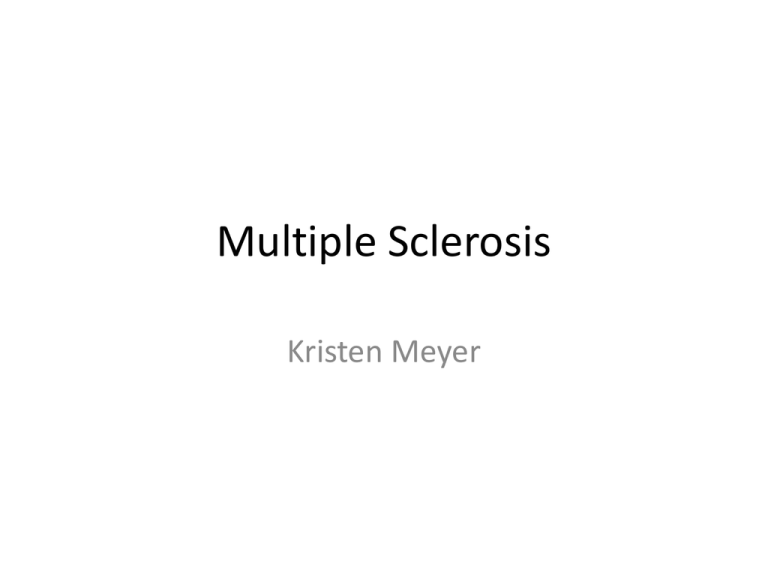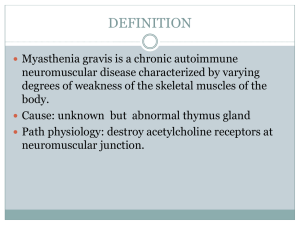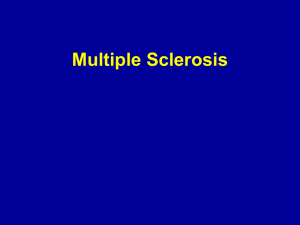Multiple Sclerosis
advertisement

Multiple Sclerosis Kristen Meyer Indroduction • • • • • • • • • • • • Definition Epidemiology Symptoms Diagnosis Tests and Evaluations Complications Treatment Effects on Exercise Medications Effects of Exercise Exercise Prescription Summary Definition • Autoimmune disease that damages the insulating myelin of the CNS. Epidemiology • • • • First diagnosed between the ages of 16-60 Peaks at age 30 More common in women- 2 or 3:1 ratio Benign and rapidly progressing Symptoms • • • • • • • • • Spasticity Incoordination Impaired balance Fatigue Muscle weakness, partial paralysis, paralysis Sensory loss and numbness Cardiovascular dysautonomia Tremor Heat sensititivy Diagnosis • At least two episodes of symptoms – Occur at different points in time – Result from involvement of different areas of the central nervous system • Absence of other treatable causes for the symptoms • Results of neurological testing Example of onset of cases • Case 1: 26 year old woman – – – – Decreased vision in the right eye in 9/05 Left leg numbness in 1/06 Right face numbness, right arm and leg weakness in 4/06 Left leg weakness in 8/06 • Case 2: 45 year old man – Left arm weakness in 2/93 – Numbness below the waist in 4/07 Diagnosis • • • • • No single test, only accepted criteria Imperfect system Neurologist evaluates symptoms Based on medical history Neurological Exam ( function of brain and spinal cord) • Skill of doctor to ask the right questions to uncover info to • 10% of MS cases are misdiagnosed Tests • MRI • Spinal taps • Lumbar punctures ( exam of cerebrospinal fluid) • Evoked potentials • Lab analysis of blood samples Accepted Criteria for Diagnosis • Age 20-60 • Signs and Symptoms idicate disease of brain or spinal cord • Evidence of ≥ 2 leasions—or abnormal areas on the brain (from MRI scan) • Objective evidence of disease of brain or spinal cord on doctor’s exam • ≥ 2 episodes lasting at least 24 hrs. at least one month apart • No other explanation for the symptoms Complications Treatment: Disease-Modifying Agents Disease-Modifying Agent Side effects that may effect exercise Interferon beta-1a (Avonex, Rebif) Flu-lik symptoms, injection site irritation Interferon beta-1a (Betaseron) Flu-like symptoms, injection site irritations Glatiramer acetate (Copaxone) Injection site irritation Mitoxantron (Novantrone) Fever or chill, swelling of legs, cough or shortness of breath Natalizumab (Tysabri) Fatigue, joint pain, depression Treatment: Symptom Management Symptom Management Side effects that may effect exercise Amantadine, modafanil (Provigil) May reduce fatigue Baclofen (Lioresal), tizandidine (Zanaflex) May cause muscle weakness and fatigue Amitriptyline (Elavil), fluoxetine (Prozac) May cause muscle weakness Prednisone May cause muscle weakness reduced sweating, hypertension, diabetes, osteoporosis Treatment











